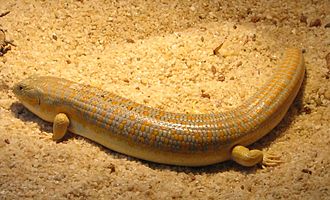Type the name of the breed you're looking for below
[wpdreams_ajaxsearchlite] Don't see the breed your're looking for? Click here and let us know!
Berber Skink
| Place of Origin and Range | Eumeces schneideri, commonly known as Schneider's skink or the Berber skink, is a species of skink endemic to Central Asia, Western Asia, and North Africa. |
| Description | Olive-grey or brownish above, uniform or with irregular golden-yellow spots or longitudinal streaks; a yellowish lateral streak, extending from below the eye to the hind limb, is constant; lower surfaces yellowish white. Head moderate; snout short, obtuse. Nasal rather large, usually divided, in contact with the two anterior upper labials. 22 to 28 scales round the middle of the body, perfectly smooth, the laterals smallest, those of the two median dorsal series very broad and larger than the ventrals. The length of the hind limb is contained 2.5 to 3 times in the length from snout to vent. When pressed against the body, the limbs just meet or fail to meet. A series of transversely enlarged subcaudals. |
| Morph Patterns Available | Yes |
| Adult Size | Can grow up to 12 in ( 30 cm) |
| Accommodation | Although they do occur in urban areas, their preferred habitat is humid forest areas with abundant leaf litter, especially oak forests. They are very active and predatory lizards, requiring a large amount of space to run. They prefer high temperatures, up to 105–110 °F (41–43 °C) at their basking spot and 80 °F (27 °C) elsewhere in their habitat during the day. Grasses and lots of things to climb on. |
| Lifespan | Can live 10+ years |
| Feeding / Diet | Like other skinks of the genus Plestiodon, they feed primarily on insects, preferring larger prey such as grasshoppers. |



